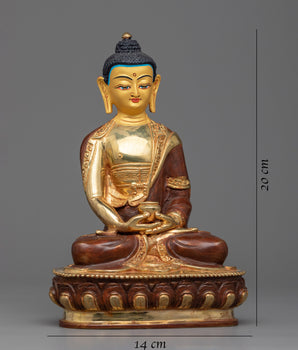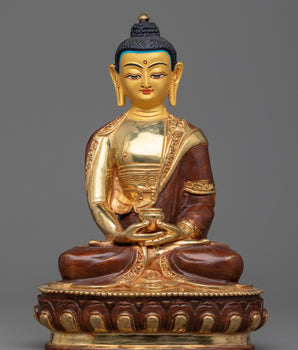A Complete Guide to Singing Bowls and Their Chakras
Singing bowls have emerged as ancient healing instruments that have become popular once again despite their straightforward but impactful character. The increasing pace of modern life causes a growing number of people to look for methods that enable them to achieve inner tranquility. Singing bowls create resonant sounds that transcend beauty to deliver effective energy healing, especially when they link with the body’s chakra system.
The areas of Himalayan Nepal and Tibet, together with Indian territories, served as the original home for singing bowls that religious traditions have utilized during meditative practices since ancient times. Striking or rubbing the edge of a bowl with a mallet generates a powerful resonant vibration that becomes equally sensed as heard by human audiology. Singing bowls create specific body-frequency correspondences that make them suitable for healing because the process depends on sound to re-establish energetic equilibrium in the body.
What Are Singing Bowls?
Tibetan singing bowls or Himalayan sound bowls represent ancient musical instruments that history shows were originally made by blending various metals, and in current times, they are also sometimes manufactured using crystal. With the help of a mallet or from direct bowing, they produce deep and resonant tones. The Himalayan regions of Nepal and Tibet, together with northern India, have been using these bowls for Buddhist spiritual purposes during meditation rituals and healing practices throughout many centuries. Their acoustic output presents itself as an investigative auditory perception rather than basic tonal resonance. The vibrational tones generated by the rings of a bowl interact with physical structures together with subtle energy patterns in a way that modern wellness practices consider highly valuable.

Singing bowls function as therapeutic instruments for global practices of sound therapy, yoga, and energy work to help people maintain emotional clarity alongside inner balance. After activation, the bowl produces harmonic tones which help the mind find tranquil silence while simultaneously creating relaxation and energy balance throughout your chakras.
How Do Singing Bowls Work?
Descriptions of singing bowls mention more than mere auditory perception because they generate physical sensations alongside audible tones. The singing bowl produces enduring layered sound waves that travel both through the air and into the body through the process of either mallet striking or rim circling. The brain wave patterns synchronize into alpha and theta frequencies due to the entraining effect that these vibrations create. The body reaches a deeply relaxed state in this environment, which allows the nervous system to find calmness while activating healing capabilities. Energy-flow healing benefits from bowls that are tuned to particular frequencies because these bowls stimulate and balance the energy centers through which they play. The energy field of the vibrational frequency contacts you to free spiritual, emotional, and physical blockages, which create clarity and alignment in your body.
What Are Chakras?
Indian spiritual traditions characterize chakras as energetic body centers that exist inside the human form. Seven central chakras exist in the body and connect to particular bodily, emotional, and spiritual aspects. The seven main chakras extend along the spine and reach the top of your head.
Balanced energy flow allows free movement that supports health and wellness in all aspects. When one of the seven main energy centers becomes obstructed, it causes problems that affect physical, emotional, and mental health. Sound healing with singing bowls provides the solution to this condition.

(Photo from Freepik)
Understanding the Chakra System
The complete understanding of singing bowl functionality with chakras requires first comprehending the essence of these energy points. The ancient Indian spiritual concept describes Chakras as spinning energy centers that run vertically along the spine. Our body contains seven main centers, which respectively control emotional, physical, and spiritual functions. Energy passes freely through these centers to grant us health and clarity, together with vitality. The healthy functioning of chakras depends on free energy flow, but disturbances occur when we have blocked or overactive energy centers.
Every chakra possesses unique properties, which include a related element and color alongside their corresponding frequency and musical note. Singing bowls possess the ability to interact with different points when they are correctly tuned because of this energy connection, which helps activate and cleanse the energy related to specific centers.
1. Root Chakra (Muladhara)
The chakra initiation occurs at the base of the spine where the root chakra, known as Muladhara, resides. This energy center controls our sense of security, together with our foundation in life and our capacity to survive. Internal equilibrium of this energy center creates the foundation for a secure position within our surroundings and physical being.
Tones played by root chakra singing bowls correspond to the musical note C. These subsonic bowl vibrations produce deep Earth-like sounds that stabilize unstable waves in order to create foundational tranquility. Using a C-note bowl enables users to achieve safer feelings and decreases anxiety during meditation. The sound creates an anchor through which scattered energy travels downwards until it brings us back to our present reality.
2. Sacral Chakra (Svadhisthana)
People will find Svadhisthana, or the sacral chakra, situated in the lower abdomen, just above the root. Svadhisthana controls our creative potential alongside emotional expression and sexuality, with the ability to find pleasure. Suppression in the sacral chakra commonly results in both suppressed emotions and diminished inspiration.
The musical foundation of the sacral chakra is represented by the musical note D. A singing bowl resonates with fluid characteristics because it has been tuned to this note, which matches the water element connection of this chakra. Playing this instrument will produce effects that create emotional relief by bringing out sensual forces and driving creative stimulation. The vibration of the bowl stimulates gentle motion, which affects both physical movements and pure energy transmission through this area.
3. Solar Plexus Chakra (Manipura)
Among the seven chakras stands the solar plexus chakra, which is named Manipura. The Manipura chakra exists in the upper abdomen part of the body where personal power and self-confidence find their residence, while self-worth finds its equilibrium. The solar plexus chakra enables people to express their willpower during social interactions with others.
A singing bowl playing the E tone activates the solar plexus chakra with bright energetic vibrations that match this frequency. Through its auditory waves, this sound creates strength within us and eliminates feelings of powerlessness and feelings of inadequacy. Playing a bowl near this energy center activates courage along with better decision-making capabilities, as well as the clarity to determine one's purpose.
4. Heart Chakra (Anahata)
The heart chakra, Anahata, is located in the center of the chest. It is the gateway between the lower physical and the higher spiritual chakras. The heart chakra governs love (both giving and receiving), compassion, forgiveness, and emotional healing.
It vibrates to the note F, and when using a singing bowl tuned to this note, you will notice a powerful and expansive tone as well as an especially soothing tone. This bowl brings us to a place where we can allow ourselves to open up to our emotional body and move beyond resentments while inviting greater feelings of compassion and empathy. This is so important, and we need to be able to move beyond the wounds we have and be able to enter the obligatory aspects of love that are not specific to whoever or whatever hurt us, even if it's ourselves.
5. Throat Chakra (Vishuddha)
The throat chakra, Vishuddha, is in the center of the throat and is restorative of communication, truth, and self-expression. When the throat point is vibrating freely, we are able to communicate what we think clearly, listen with compassion, and express our true selves.
The musical note that correlates to this chakra is G. The sounds of the singing bowls tuned to this frequency have such a clear and resonant tone that can cut through confusion and indecision. The sound helps to clear the congested energies within the throat and neck areas to support verbal self-expression and inner honesty. This frequency is especially helpful for those who may struggle with speaking up for themselves and/or for those who continually feel misunderstood.

6. Third Eye Chakra (Ajna)
The third eye chakra, also known as Ajna, is located between the eyebrows. This center relates to intuition, inner vision, perception beyond ordinary experience, and allows us to trust our instincts and spiritual insight.
The third eye chakra is linked with the musical note A. When a singing bowl tuned to this note is struck, the high crystalline tone helps to quiet the rational mind, allowing for greater awareness of our state of consciousness. The tonal sound helps with quieting the mind to support stillness and contemplation, it may help with meditation by quieting expressive mental noise. It is helpful, especially for those who are seeking clarity, spiritual direction, or just being able to access deeper states of intuitive understanding.
7. Crown Chakra (Sahasrara)
The crown chakra, Sahasrara, the 7th energy center, is located at the crown of the head. This energy center is our access point to higher consciousness, universal truth, and spiritual enlightenment. This chakra also connects us to something much greater than ourselves. The crown point is the end of the chakra path.
The crown chakra is also the note B. If you sound a singing bowl tuned to B, the sound is high-frequency, ethereal, and transcendent. This sound connotes a sense of spaciousness, allowing the ego to quiet, allowing the door to open to the potential for unity, divine connection, and infinite awareness. A singing bowl sounds using the frequency of B can often guide you to a state of deep spiritual peace and oneness while meditating.
|
Chakra |
Frequency in Hz |
Note |
|
Root |
432 |
C |
|
Sacral |
480 |
D |
|
Solar Plexus |
528 |
E |
|
Heart |
594 |
F |
|
Throat |
672 |
G |
|
Third Eye |
720 |
A |
|
Crown |
768 |
B |
How Singing Bowls Work in Chakra Healing
Fundamentally, the singing bowl is an implement of vibrational medicine; a vessel of vibrational medicine. Everything in our bodies is humming with its own frequency. The heart has a frequency. The neurons firing have a frequency. However, there is much in life that can tamper with the fine-tuned frequency of the body. The singing bowls provide a gentle way to bring your inner harmonies back into alignment. When you play a bowl, you'll hear a deep, sustaining tone. The sound we hear wraps around our body, almost like a hug from the vibration. The sound is not just heard, but felt within the body. The boy has electric pulses surrounding the sound throughout the air, travelling deep into the tissues, and shifting the energy in the tissues. Where there was once restriction or tension, the sound creates a space. This is called entrainment. The body, through the listening experience of the sound, begins to match the stable, calming frequency of the bowl, and then it can subsequently be chosen to settle effortlessly and without “force” back to balance.

The effect of singing bowls is amplified when used in conjunction with meditation and basic yoga poses that focus on energy points. Certain movements and attentive awareness activate each chakra. For example, when we sit in Hero's Pose with a root energy point bowl (note C) being played, it enhances a sense of grounding. A sacral bowl (note D) being played while we practice Butterfly Pose works to help release emotional tension in the pelvic structure and promote opportunities for creativity. The sounds associated with the Heart energy point resonate beautifully with gentle backbends such as Cobra Pose, especially when linked with breathwork or loving-kindness meditation. Together, they enable the body and energy centres to open as one—in this case, the movement is activating the energy points physically, while the bowl is resonating and supporting its vibration. Combining the bowl with yoga also serves to deepen the healing experience and encapsulate a fuller embodied sense of healing.
But most of all, the most intriguing effect of singing bowls is the effect it has on the mind. The sound takes you within, it softens the incessant inner dialogue, and creates space for stillness. The brain waves begin to slow, letting you enter that meditative dream, where real healing can happen. In that space, the body relaxes, the breath deepens, and emotions come and go, without resistance. Time seems to stretch. For a few minutes, or seconds, you come back to yourself—clear, open, connected. That is the wonder of singing bowls. They don't just produce beautiful sounds—they help you remember what it feels like to feel whole.
Choosing the Right Singing Bowl
There is no correct answer on which bowl to choose. It depends on your intention, your level of experience, and what type of bowl resonates with you. Hand-hammered metal bowls will typically resonate more with layered tones and will have naturally occurring imbalances, which many people find grounding and authentic. Crystal singing bowls, made mostly of quartz crystal, have precise high-frequency tones that are often more acute and focused.
Larger bowls will produce deeper, richer tones perfect for opening and balancing the root or sacral chakra. Smaller bowls will create higher pitches and correspond with the upper chakras, like the third eye and crown. When selecting a bowl for use with a particular energy point or to create a whole set, it is best to take the time to listen to it and feel the vibration it creates before settling on a bowl. Let your intuition lead the way. After all, sound healing is a personal experience.
Integrating Singing Bowls Into Daily Practice
Keeping a consistent practice is fundamental to working with singing bowls and chakra healing. One session is enough to shift energy patterns, but a practice will create more depth, and stability of an energetic shift. You could start or end your day with five minutes of sound meditation with a singing bowl on a single point or a full set of singing bowls for the seven energy points. Many people find that combining the practice of singing bowls with breathwork, visualization, or yoga can deepen the energetic experience.
There is no specific order you need to follow. The most significant thing is presence, allowing the sound to take you inward. Eventually, the tones will be familiar signals that tell your body and mind to relax, open, and come into alignment. You will start to notice the smallest new experiences concerning your mood, energy, or thinking. As you listen, you get closer to your own inner landscape.
The Resonance of Ancient Wisdom
Singing bowls and chakra healing are not new age fads; they are ancient practices rooted in centuries of spiritual journeys and energetic understanding. When you pick up a bowl and let it sound into your space, or into your hand, you are immersed in a tradition that has helped countless people reconnect with themselves and with the world at large.
The beauty of singing bowls is not only the sound but the soft transformations that may come from listening. They provide a gentle, non-invasive way to let go of tension that does not need to be held anymore, rebuild balance, and invite harmony back into your system. In a world that often takes more than it gives, the simple act of listening to the pure and resonant tone from a singing bowl can be profoundly healing towards self-care and spiritual remembering.















